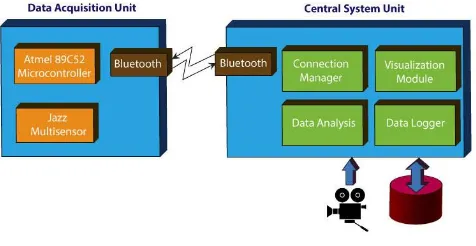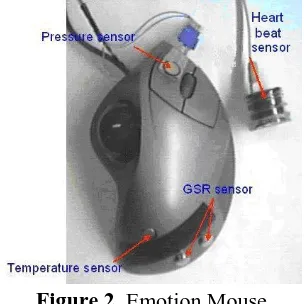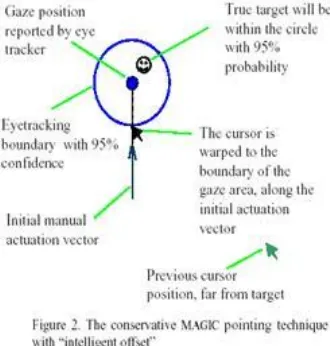CSEIT17268 | Received : 01 Nov 2017 | Accepted : 08 Nov 2017 | November-December-2017 [(2)6: 12-16]
International Journal of Scientific Research in Computer Science, Engineering and Information Technology © 2017 IJSRCSEIT | Volume 2 | Issue 6 | ISSN : 2456-3307
12
Detecting human Emotions : Blue Eyes Technology
Abhilasha Sondhi
Department of Computer Science, Shaheed Bhagat Singh State Technical Campus, Ferozepur, Punjab, India
ABSTRACT
Blue Eye is defined as the technology that provides means for monitoring and recording the user‟s basic physiological parameters. If we add such abilities to the computer then it will make the computer more powerful. It uses facial recognition and speech recognition technologies, a mouse that can feel and touch. This type of computer can also recognize our emotions and physical state. The “BLUE EYES” technology creates computational machines that have perceptual and sensory ability like those of human beings which gathers information from the users and starts interacting with them according to their mood variations.
Keywords: Blue-eyes, DAU, CSI, GSA, MDS, Magic-pointing, speech recognition, Simple User Interest Tracker (SUITOR).
I.
INTRODUCTION
Blue in this term stands for Bluetooth, which enables reliable wireless communication and the Eyes because the eye movement enables us to obtain a lot of interesting and important information. The basic idea behind this technology is to give computer human power. The Blue Eye system has hardware with software loaded on it. Blue Eye system can be applied in every working environment requiring permanent operator's attention for it. Imagine yourself in a world where humans interact with computers. You are sitting in front of your personal computer that can listen, talk, or even scream aloud. It has the ability to gather information about you and interact with you through special techniques like facial recognition, speech recognition, etc. It can even understand your emotions at the touch of the mouse. It verifies your identity, feels your presence, and starts interacting with you. You ask the computer to dial to your friend at his office. It realizes the urgency of the situation through the mouse, dials your friend at his office, and establishes a connection.
The hardware comprises of data acquisition unit and central system unit. The heart of data acquisition unit is ATMEL 89C52 microcontroller. Bluetooth technology is used for communication and coordination between
the two units. Blue eye system can be applied in every working environment, which requires permanent operator‟s attention. Blue eye system provides technical means for monitoring and recording human operator‟s physiological condition. A blue eye is a project aiming to be a means of stress reliever driven by the advanced, technology of studying the facial expressions for judgment of intensity of stress handled. In totality blue eye aims at adding perceptual abilities which would end up in a healthy stress free environment and can be applied in every working environment requiring permanent operator‟s attention. It uses non-obtrusive sensing method, employing most modern video cameras and microphones to identify the user‟s actions through the use of imparted sensory abilities. The machine can understand what a user wants, where he is looking at, and even realize his physical or emotional states.
II.
PARTS OF THE BLUE EYE TECHNOLOGY
Blue eyes system monitors the status of the operator‟s visual attention through measurement of saccadic activity. The system checks parameters like heart beat rate and blood oxygenation against abnormal and triggers user defined alarms. Blue Eyes system consists of a mobile measuring device and a central analytical system. The mobile device is integrated with Bluetooth module providing wireless interface between sensors worn by the operator and the central unit. ID cards assigned to each of the operators and adequate user profiles on the central unit side provide necessary data personalization.
Figure 1. Parts of Blue Eyes Technology
A. Data Acquisition Unit (DAU)
The DAU used in the Blue Eyes technology is the mobile component of the system. The main function of DAU is to gather the physiological information from sensors and forward to the CSU for processing and verification purposes The Bluetooth module, which is integrated with the mobile device (DAU), provides a wireless interface between the Central System Unit (CSU) and the user or operator having the sensors. PIN codes and ID cards are assigned to the entire operator‟s for authentication purposes. The device uses a five-key keyboard, beeper and LCD display for the interaction with the operators and if, any unwanted situation occurs, the machine uses these devices to inform the operators. The „voice‟ information from the user is transferred with the help of a headset, which is interfaced with the Data Acquisition Unit using a mini jack plug. DAU incorporates various hardware modules like system-core Bluetooth section, Atmel 89C52 microcontroller, EEPROM, Beeper, LCD display (HD44780), LED indicator, voltage level monitors and 6 AA batteries.
B. Central System Unit (CSU)
CSU is the next squint of wireless-network connection in the Blue Eyes technology. The CSU mainly contains codec (PCM Codec commonly used for voice information transmission) and a wireless blue tooth module. This CSU section is integrated to a personal computer using USB, parallel and serial cable. The mini-jack socket is used for audio data accessing. The program containing the operators personal ID is amalgamating to the personal computer through the serial and power ports. The microcontroller (Atmel- 89C2051) inside the unit handles the I2C EEPROM- programming and UART transmission.
III. EMOTION COMPUTING
A. Theory
the five minute baseline and test sessions. GSA data was sampled 80 times per second, GSR and temperature were reported approximately 3-4 times per second and pulse was recorded as a beat was detected, approximately 1time per second. To account for individual variance in physiology, we calculated the difference between the baseline and test scores. Scores that differed by more than one and a half standard deviations from the mean were treated as missing. By this criterion, twelve score were removed from the analysis. The results show the theory behind the Emotion mouse work is fundamentally sound.
B. Emotional Sensors
1. For Hand , Emotion Mouse:
One goal of human computer interaction (HCI) is to make an adaptive, smart computer system. This type of project could possibly include gesture recognition, facial recognition, eye tracking, speech recognition, etc. Another non-invasive way to obtain information about a person is through touch. People use their computers to obtain, store and manipulate data using their computer. In order to start creating smart computers, the computer must start gaining information about the user. Our proposed method for gaining user information through touch is via a computer input device, the mouse.
From the physiological data obtained from the user, an emotional state may be determined which would then be related to the task the user is currently doing on the computer. Over a period of time, a user model will be built in order to gain a sense of the user's personality. The scope of the project is to have the computer adapt to the user in order to create a better working environment where the user is more productive
Figure 2. Emotion Mouse
2. For Eyes , Expression Glasses:
Expression Glasses provide a wearable "appliance-based" alternative to general-purpose machine vision face recognition systems. The glasses sense facial muscle movements, and use pattern recognition to identify meaningful expressions such as confusion or interest.
A prototype of the glasses has been built and evaluated. The prototype uses piezoelectric sensors hidden in a visor extension to a pair of glasses, providing for compactness, user control, and anonymity.
Figure 3. Expression Glasses
3. Manual and Gaze Input Cascaded (Magic) Pointing :
accomplish Manual Acquisition with Gaze Initiated Cursor or Manual and Gaze Input Cascaded (MAGIC)
pointing. Two MAGIC Pointing methods –
conservative and liberal –in terms of cursor placement and target identification, were outlined, analyzed and executed with an eye tracker unit.
Figure 3. The Liberal MAGIC pointing technique cursor is placed in the vicinity of a target that the user
fixates on
Figure 4. The Conservative MAGIC pointing technique with intelligent offset
Advantages of MAGIC Pointing Technique:
Reduced physical effort compared with the traditional manual pointing techniques.
Greater spontaneity than traditional manual pointing.
Greater accuracy.
Faster speed of operation than manual pointing.
Drawbacks of MAGIC Pointing Technique:
The unconscious jittery movement that an eye continually makes and also the one degree size of the fovea, eye gaze method is not accurately enough to
perform UI widgets such as slider handles, scrollbars and hyperlinks on the Graphic User Interfaces. Sometimes the movement of the eye is spontaneously controlled while sometimes it is uncontrollable. In MAGIC pointing many methods such as eye blinking and continuous looking etc. are used for target selection procedures. But sometime it is not working properly because if a user does not look at a particular target continuously for a predetermined threshold value, the target will not be selected. Thus there are more chances for false selections.
4. For Voice, Artificial Intelligent Speech Recognition:
It is important to consider the environment in which the speech recognition system has to work. The grammar used by the speaker and accepted by the system, noise level, noise type, position of the microphone, and speed and manner of the user‟s speech are some factors that may affect the quality of speech recognition. The user speaks to the computer through a microphone, which, in used; a simple system may contain a minimum of three filters. The more the number of filters used, the higher the probability of accurate recognition. Presently, switched capacitor digital filters are used because these can be custom-built in integrated circuit form. These are smaller and cheaper than active filters using operational amplifiers. The filter output is then fed to the ADC to translate the analogue signal into digital word. The ADC samples the filter outputs many times a second. Each sample represents different amplitude of the signal. Each value is then converted to a binary number proportional to the amplitude of the sample. A central processor unit (CPU) controls the input circuits that are fed by the ADCS. A large RAM (random access memory) stores all the digital values in a buffer area. This digital information, representing the spoken word, is now accessed by the CPU to process it further. The normal speech has a frequency range of 200 Hz to 7 kHz. Recognizing a telephone call is more difficult as it has bandwidth limitation of 300 Hz to3.3 kHz
5. The Simple User Interest Tracker (Suitor)
analyzes the user that where his eye focus on the personal computer screen. The SUITOR has the ability to determining the topic of interest of the user and also according to this it can able to deliver the appropriate data to a handheld device
IV. CONCLUSION
The Blue eyes technology ensures a convenient way of simplifying the life by providing more delicate and user-friendly facilities in computing devices. Now that we have proven the method, the next step is to improve the hardware. Instead of using cumbersome modules to gather information about the user, it will be better to use smaller and less intrusive units. The day is not far when this technology will push its way into your household, making you lazier. A blue eye is a technology aiming to be a means of stress reliever driven by the advanced, technology of studying the facial expressions for judgment of the intensity of stress handled. These new possibilities can cover areas such as industry, transportation, military command centers or operation theaters.
V.
REFERENCES
[1].Kenneth Holmqvist, Marcus Nyström, and Fiona Mulvey. Eye tracker data quality: what it is and how to measure it. In Proceedings of the Symposium on Eye Tracking Research and Applications, pages 45–52. ACM, 2012. [2].KRyu,et.al.,“AgentMultiplication :An
Economical Large scale Testing Environment for System Management Solutions", Workshop
on System Management Techniques,
Processes, and Services (SMTPS), April 2008. [3].Deeksha Rajvanshi Overview of Blue Eyes
Technology SSRG International Journal of Electrical and Electronics Engineering (SSRG-IJEEE) – volume 2 Issue 8 , AUGUST 2015 [4].Priya R. Baghe Blue Eyes Sensing
Intelligences Technology Using Emotion Sensor International Journal of Applied Engineering, Research and Development (IJAERD) ISSN(P):2250-1584; ISSN(E): 2278-9383,Vol. 4, Issue 2, Apr 2014, 113-122 [5].Kritika R.Srivastava, Karishma A. Chaudhary,
Prof. H.J.Baldaniya Vision System of Blue Eyes International Journal of Emerging


